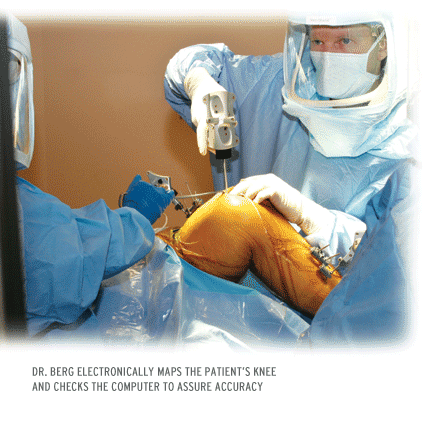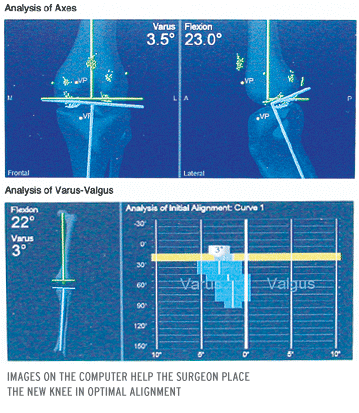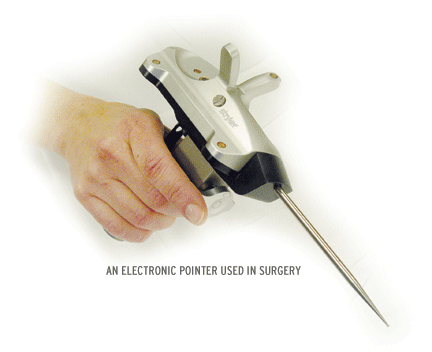Navigation System
Assists Knee Replacement
By Troy Berg, MD
Sports Medicine & Arthroscopy
Chippewa Valley Orthopedics & Sports Medicine, Eau Claire
Computer-guided knee replacement surgery is an exciting new development
that will likely revolutionize the way knee replacements, and many other
orthopedic surgeries,
are carried out.
The computer guidance systems are technically termed "navigation
systems". Just such a navigation system has been installed at
the OakLeaf Surgical Hospital for use by OakLeaf member orthopedic surgeons.
Similar to the way a GPS unit gives us a detailed electronic map of
our surroundings; the knee navigation system gives the surgeon a detailed
map of the patient's knee.

During surgery, temporary markers are placed through tiny incisions
into the patient's femur (thigh bone) and tibia (leg bone). The
navigation unit, which consists of a wireless sensor and a computer,
picks up the signals transmitted by the markers. The surgeon then uses
a digital probe to record the location of various points in the patient's
knee and a digital map is made by the computer. The hip and ankle anatomy
is also recorded. The result is a detailed, electronic map of the patient's
knee in both static (still) and dynamic (moving) conditions.

Why is this electronic map useful? Think of an automobile.
A new tire placed on a wheel that is out of alignment will not last
as long as it would if the car's alignment was corrected at the
same time that the tire was replaced. The same holds true for knee replacements.
They are mechanical devices that function best, and last longest, if
they are placed in optimal alignment. Traditional knee replacement alignment
guides used in surgery have done quite well. However, their tolerances
are not precise and misalignment can result. This can happen particularly
if the patient's leg is large or if there are significant bony
deformities. The computerized map from the navigation system gives precise,
reproducible measurements from which the surgeon can plan and then place
the patient's knee replacement in ideal three-dimensional alignment.

Many patients today have questions about minimally invasive knee replacement
surgery. While it is natural for patients to want their knee replacement
surgery to be done through the smallest incision possible, the length
of the incision is the least important factor in the results of the
surgery. In fact, incisions that are too small can lead to problems
- misaligned knee replacements, wound healing difficulties, and generally
inferior outcomes. What has been shown to speed recovery is what is
termed "the quadriceps sparing approach" in which the muscles
in the thigh are gently split to approach the knee rather than the traditional
incision into the quadriceps tendon. It is important to keep in mind,
however, that the most important factor for longevity and function of
knee replacements is optimal alignment. The navigation system greatly
assists in achieving ideal alignment of knee replacements, particularly
in quadriceps sparing approaches where the whole knee is not as readily
visualized when compared to the traditional approach.



